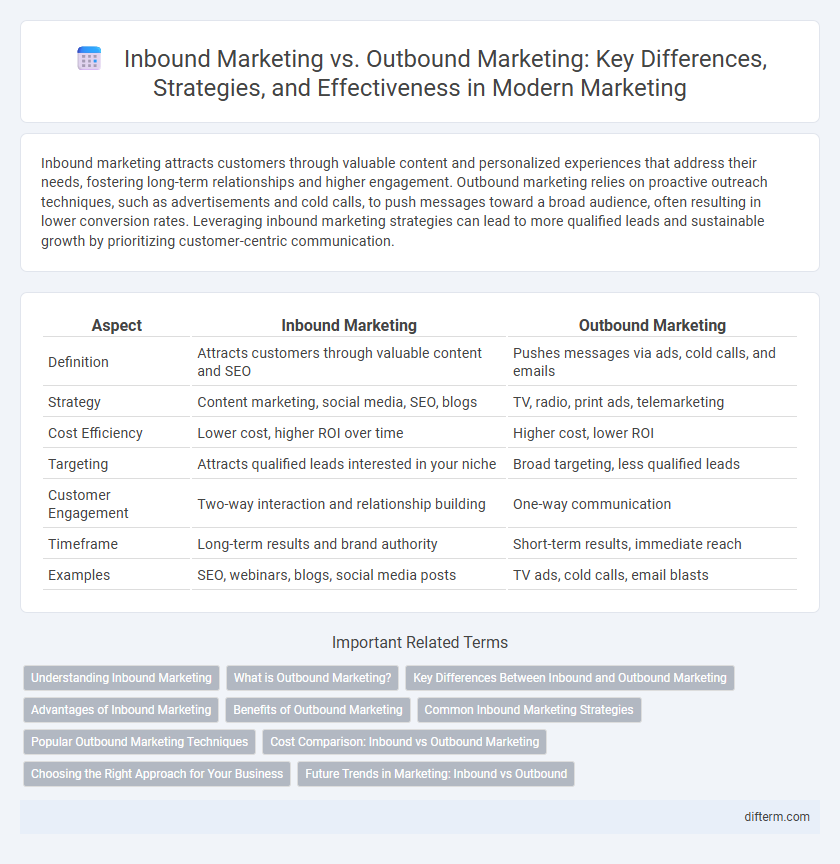Inbound marketing attracts customers through valuable content and personalized experiences that address their needs, fostering long-term relationships and higher engagement. Outbound marketing relies on proactive outreach techniques, such as advertisements and cold calls, to push messages toward a broad audience, often resulting in lower conversion rates. Leveraging inbound marketing strategies can lead to more qualified leads and sustainable growth by prioritizing customer-centric communication.
Table of Comparison
| Aspect | Inbound Marketing | Outbound Marketing |
|---|---|---|
| Definition | Attracts customers through valuable content and SEO | Pushes messages via ads, cold calls, and emails |
| Strategy | Content marketing, social media, SEO, blogs | TV, radio, print ads, telemarketing |
| Cost Efficiency | Lower cost, higher ROI over time | Higher cost, lower ROI |
| Targeting | Attracts qualified leads interested in your niche | Broad targeting, less qualified leads |
| Customer Engagement | Two-way interaction and relationship building | One-way communication |
| Timeframe | Long-term results and brand authority | Short-term results, immediate reach |
| Examples | SEO, webinars, blogs, social media posts | TV ads, cold calls, email blasts |
Understanding Inbound Marketing
Inbound marketing emphasizes attracting potential customers through valuable content, search engine optimization (SEO), and social media engagement, creating meaningful interactions that build trust and brand loyalty. By providing informative blogs, webinars, and personalized email campaigns, businesses nurture leads organically, reducing acquisition costs compared to traditional outbound methods. This approach leverages data analytics and user behavior to refine strategies, resulting in higher conversion rates and long-term customer retention.
What is Outbound Marketing?
Outbound marketing refers to traditional advertising methods where marketers push messages to a broad audience through channels like TV commercials, radio ads, cold calls, direct mail, and display advertising. It relies on interruption-based tactics aiming to capture the attention of potential customers who may not be actively seeking the product or service. This strategy often involves higher costs and lower engagement rates compared to inbound marketing approaches.
Key Differences Between Inbound and Outbound Marketing
Inbound marketing focuses on attracting customers through content creation, SEO, and social media engagement, while outbound marketing relies on traditional advertising methods like TV, radio, and cold calling. Inbound strategies prioritize building long-term relationships and trust with prospects by providing valuable information, whereas outbound marketing emphasizes reaching a broad audience quickly to generate immediate leads. Data shows inbound marketing generates 3 times more leads per dollar spent compared to outbound approaches, highlighting its cost-effectiveness and targeted nature.
Advantages of Inbound Marketing
Inbound marketing offers higher cost-efficiency by attracting qualified leads through content marketing, SEO, and social media engagement, resulting in better ROI compared to outbound strategies. It fosters stronger customer relationships by providing valuable, tailored content that builds trust and brand loyalty over time. Inbound techniques enable precise targeting and measurable analytics, allowing marketers to optimize campaigns continuously for improved conversion rates.
Benefits of Outbound Marketing
Outbound marketing generates immediate visibility and reach through targeted ads, cold calls, and direct mail campaigns, driving fast customer acquisition. It allows precise control over messaging and timing, ensuring consistent brand exposure across multiple channels. This approach effectively targets broad or new audiences, accelerating lead generation in competitive markets.
Common Inbound Marketing Strategies
Common inbound marketing strategies include content marketing, search engine optimization (SEO), and social media engagement, which all aim to attract and engage potential customers by providing valuable information. Utilizing blogs, videos, and ebooks helps educate audiences and build trust, while targeted SEO maximizes organic traffic from relevant search queries. Interactive social media campaigns and personalized email marketing further nurture leads by maintaining consistent, value-driven communication.
Popular Outbound Marketing Techniques
Popular outbound marketing techniques include cold calling, direct mail campaigns, and television or radio advertisements that proactively reach a broad audience. These methods emphasize pushing messages to potential customers through interruption-based strategies such as pop-up ads, email blasts, and event sponsorships. Despite evolving digital trends, outbound marketing remains effective for brand awareness and immediate lead generation across diverse demographics.
Cost Comparison: Inbound vs Outbound Marketing
Inbound marketing typically incurs lower costs than outbound marketing due to its reliance on content creation, SEO, and organic social media engagement. Outbound marketing requires significant investment in paid advertisements, cold calling, and direct mail campaigns, often resulting in higher overall expenses. Businesses experience a higher return on investment (ROI) with inbound marketing by targeting qualified leads and reducing wasted marketing spend.
Choosing the Right Approach for Your Business
Selecting the right marketing approach hinges on understanding your business goals, target audience, and budget. Inbound marketing leverages content creation, SEO, and social media to attract qualified leads organically, ideal for long-term brand building and cost efficiency. Outbound marketing focuses on direct outreach through ads, cold calls, and email campaigns, providing faster results and greater control over audience targeting for immediate sales impact.
Future Trends in Marketing: Inbound vs Outbound
Future trends in marketing highlight a shift toward inbound marketing strategies driven by advanced AI analytics and personalized content experiences, increasing customer engagement and conversion rates. Outbound marketing still holds value through targeted programmatic ads and omnichannel campaigns but is becoming more data-intensive and automated to optimize ROI. Integrating inbound and outbound approaches with evolving technologies like machine learning and customer journey mapping will define competitive marketing landscapes.
inbound marketing vs outbound marketing Infographic

 difterm.com
difterm.com